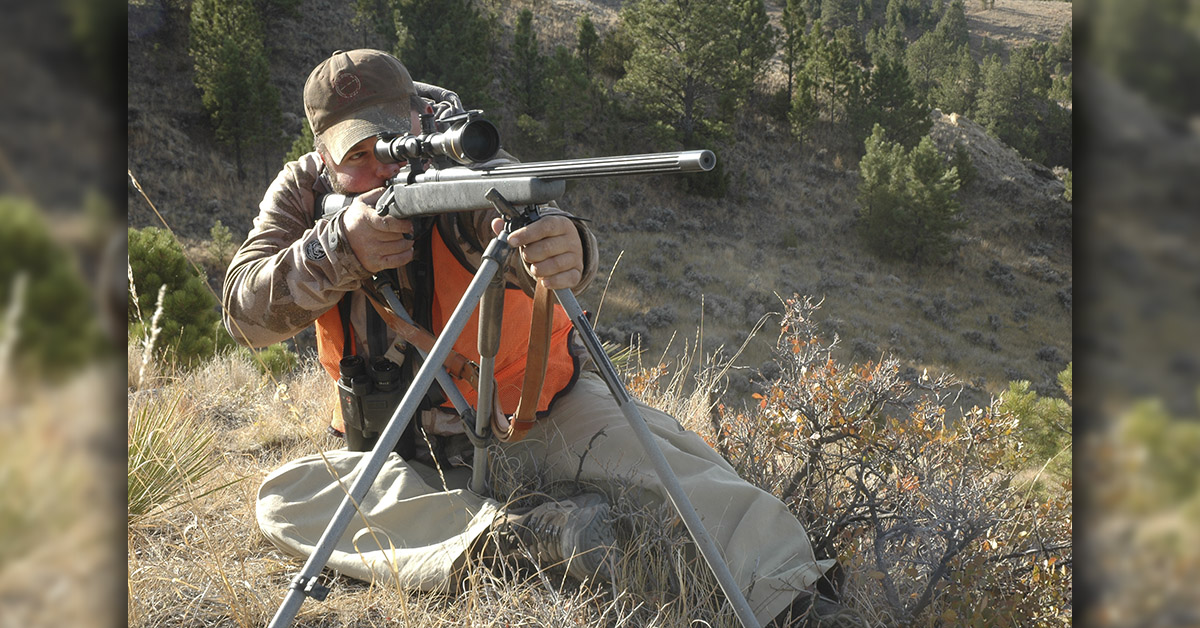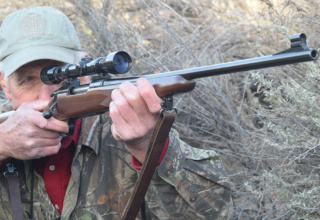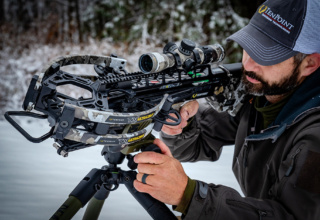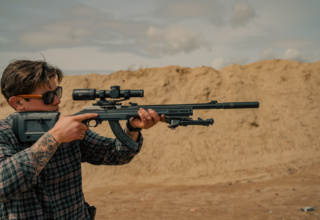Accuracy from the bench means little if you can’t steady the rifle on a hunt!
by Wayne van Zwoll
Snow was screening the peaks, so right out of the cabin, he tucked his binocular into his jacket. His rifle hung, muzzle down, from his shoulder. He snatched up a stout walking stick from under the eve and set out in ankle-deep powder. I followed.
The stick was about 7 feet long — not a manufactured item, but one cut from the forest, stripped of its bark, smoothed and varnished. Thick enough to fill a fist and to bear the weight of a man if he fell on the steeps, it still had knot-knobs. It seemed to pull him up the mountain.
His English was better than my German. “Does the stick help you shoot?” I asked during a pause to suck thin Austrian air. The rifle’s strap was clearly of little use as a shooting sling. He nodded, then, to demonstrate, jammed the stick into the snow, its low end angled out across-slope. With practiced ease, he swung the Mauser off his shoulder and settled it on his fingers along-side the stick.
“You can rest the rifle, or hold it in some fashion against the stick,” he said. “The point is to let the stick bear its weight. The wood has no muscles to tire or twitch, no pulse, no joints. It helps you shoot better. When you get above a chamois, the stick must be long enough to grip the earth sloping away from you, while supporting the rifle where you need it for the shot.”
He used the stick a lot just walking, leaning on it to take weight off his quads on the climb, and to ease pressure on his knees during descents. By day’s end, I wished for one.
But old shooting habits die hard. The next morning, prone in the snow, my taut sling brought the .270’s crosswire to a near-stop on the ribs of a chamois 150 yards off. At the report, the animal pitched on its nose.
The walking stick is an ancient device, and its use as a shooting aid dates to the earliest firearms.
Wood-cuts show soldiers in armor supporting primitive arquebuses on single sticks. Even cavalry used them! The 15th-century petronel, essentially a small cannon barrel, rested on a forked stick planted on the saddle. The soldier held the butt against his chest, pivoting the petronel on the stick as he torched a charge with a smoldering wick, all the while keeping his seat in battle! The primitive germ of a John Wayne role!

The walking stick as rifle rest endures in Europe. It’s as common in the Scottish highlands as in the Alps; less so stateside. A few years ago, as fog cleared above a cold fen, my gillie pulled a telescope from under his slicker. He sat, extended its tubes to duck-gun length, and held it against his walking stick, propped vertically. I couldn’t have looked for long through a single 25x barrel jitterbugging three feet above the earth on a stick with a single, tentative toe in wet heather! But myriad stags had been found this way, and my host had so learned his craft.
Two sticks are better, crossed to support your glass or rifle and planted wide apart, as you’d stand if steadying yourself against the wind. Crossed-stick support was routine during the 1870s in our frontier West, as hunters under contract from railroads and the U.S. government reduced the great bison herds to bleaching bones. Shots “off sticks” now account for most African plains animals killed by sport hunters, even those from countries in which pairs of sticks are more common in Chinese restaurants. Traditionally carried and set by the PH or a tracker, shooting sticks are salvation when you must fire standing — a faster position than any other and often the only practical option in tall grass or thick bush.

A pair of sticks whittled from saplings or branches and joined by a strip of leather or inner-tube weighs almost nothing. It’s easy to use, collapsed, as a walking stick, or as a wand to part grass or brush for easy passage.
These days, two sticks are giving way to three for plains game hunts. The third, planted forward, resists back-and-forth movement, which causes bullets to fly high and low. But tripods beg more attention on the trail, lest they rattle. When trying to set them quickly on uneven ground, one, then another seems always to pop free of the earth. Slopes defy three feet as all fight for purchase.

The advantage of a tripod’s steadier support isn’t lost on Africa’s PHs. Commercial tripods have gained favor because they’re easier than sticks to control, and adjustable so a shooter gets a rest of near-perfect height when speed matters. Grip-actuated ball pivots let you swing the rifle smoothly to follow an animal or catch aim at another without re-setting the legs. Padded forend rests baby your rifle and keep it from slipping or twisting. But not all refinements are improvements. The light weight and simplicity of a pair of wooden sticks are both endearing and practical.
Carbon fiber (CF) legs and clever, nearly silent pivots have made commercial tripods lighter and more useful. One example: the CF32 in a tripod series from Athlon Optics. The “32” indicates greatest leg diameter in millimeters; ditto for the CF36 and CF40. The CF29 shares the 32’s top leg diameter, its maximum and minimum height (65 and 9 inches), and also folded length (26 inches). The CF32 is load-rated to 55 pounds, the CF29 to 33 pounds. At 5.7 pounds carrying weight, the CF32 is just 3 ounces heavier.

These tripods feature four-section, vibration-damping CF legs. Lightweight but rigid, they come with tough Velcro-secured camo wrap. A center “hammock,” a pad for the carrying strap, and a zippered carrying case are of that fabric, too. Grooved rubber sleeves tighten leg extensions. They’re big enough to grasp easily. I find such sleeves have a longer service life than lever-locks, and they resist snagging in brush. Tabs on the legs can be flipped to drop this tripod low enough to concern a cockroach. The hard-polymer feet grip floors without marring them. Spikes are optional but, in my view, unnecessary. The polymer finds crevices in rock and grabs most natural surfaces.
CF-series tripods from Athlon Optics retail at $600 to $875 but sell for less. Each includes a bowl mount and a ball head, easily interchanged. A ball head that moves on all axes is as helpful under a rifle as under a movie camera. Athlon CFs are Arca-compatible.

While a tripod can hold a camera or spotting scope motionless, it has traditionally supported only the front of a rifle. The Arca (or Arca-Swiss) rail, well known in photography circles, is catching on as a stand-only rifle support. Developed in the 1990s by a German firm, it comprises a grooved (dove-tailed) plate that slips into a clamp, which secures it. Think of a scope ring on a grooved .22 receiver. Arca plates first appeared on the bellies of heavy cameras. Tripods had the mating base.
Arca-supported on the ball of a tripod like the CF32, a rifle can be moved on multiple axes, like a spotting scope. At or near the rifle’s balance point, it needs no additional support from the shooter. After you snug the ball, the rifle is a gun emplacement. It becomes one with the tripod.
A few months ago, I fired a Gunwerks rifle on a tripod with an Arca-Swiss base. Despite a gusty Wyoming breeze, the rifle perched stone-still. Gingerly, as if on a first date, I cuddled up and with the ball adjustment quartered a 200-yard target. Five shots printed a tight group. Despite the .300 PRC’s healthy recoil, only minor tweaks were needed between shots to center the reticle. And that with the tripod’s legs extended for standing shots!

Arca-Swiss unions aren’t cheap. Plates are machined of high-quality alloy to precise dimensions. (Beware knock-offs that don’t interchange with Arca fittings.) A tripod for a rifle fitted with an Arca rail weighs as much as a pregnant ‘possum, so isn’t a good fit for catch-as-catch-can hunting.
With sticks or a tripod (or a rifle’s bipod) supporting the fore-stock in a traditional way, control of that rifle behind point of balance is still up to you, the shooter.

Position matters. Prone is steadiest for several reasons, largely because the rifle’s stock snugs into your shoulder, supported inches off the ground by your solidly anchored elbows. The earth supports your legs and lower torso. A taut sling adds stability; so does a bag or your fist under the stock’s toe. But standing, kneeling, even sitting, your elbows and torso have no contact with earth. The rifle moves a lot more than it does in prone; however, solid, support up front can control movement caused by the quivering protoplasm behind the rifle!
There are techniques to help you shoot better with the handicap of a beating heart.

If your rifle is equipped with a forend-mounted bipod, use it prone this way: After aligning your body so the rifle points naturally at the target, pull the butt firmly into your shoulder, with no tension on the bipod feet. Then, press the feet to earth and lean forward to “load” the bipod, forcing its feet to grab and produce static compression from that anchor through the rifle to your shoulder. This pressure should cement your position, the rifle coming out of recoil nearly centered on the target. I’ve found the popular Harris bipod a champ for shooting prone. Quick and easy to install or detach from a standard QD swivel stud, it is strong and stable. Leg length on the standard model adjusts to the limits of prone positions.
Changing forend support often changes point of impact. If you expect to fire at game over sticks, or from a tripod or a forend-mounted bipod, practice over that support, not from a sandbag! Place it where and how you’ll probably use it afield. Your head position in relation to the sight also shifts with position changes. Firing prone, your head will tip forward, closer to the scope. Consciously pulling back to avoid contact in recoil compromises your position. Move that scope forward! Better a little too much distance to that eyepiece than too little.

Rimfire competition put me onto the benefits of a shooting sling, and I’ve used one (a Brownells Latigo) for more than 40 years afield. I prefer it to sticks and tripods because it adds nothing to my kit or the rifle, requires no help, imposes no noise or motion, and helps in all positions except standing. (Distant game needn’t be shot offhand. I can practice to make the occasional close poke standing without assist.)
Don’t assume sticks or a tripod are your ticket to a lethal hit. You may not have time to use either. The rifle might not be steady enough for a long shot or one through a tight alley. Prone over a rifle fitted with a bipod or snugged tight by a sling or immobile on a natural rest, you’ll be better served.

Still, when low bullet paths are blocked, even a walking stick can help put shots on target!
















